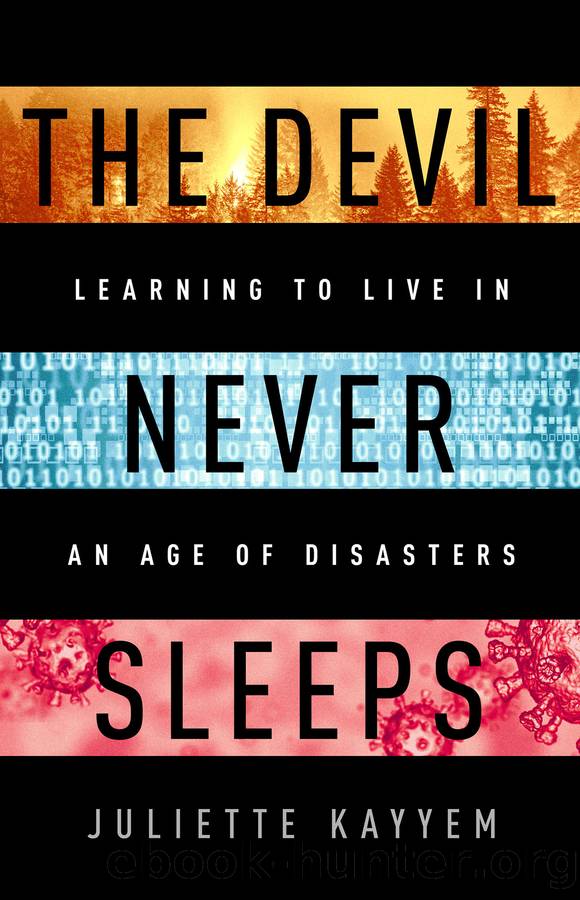The Devil Never Sleeps by Juliette Kayyem

Author:Juliette Kayyem [Kayyem, Juliette]
Language: eng
Format: epub
Publisher: PublicAffairs
Published: 2022-03-29T00:00:00+00:00
NO REGRETS AND AN EXIT
The process of planning around the last line of defense will likely illuminate ways in which preparedness and response planning can be better managed for the future when the devil comes again. Engineers I have worked with call it a âno regretsâ improvement. Maybe what you find in a review wonât actually be that consequential if fixed, but whatâs the harm? If not needed this time, the devil is sure to return again. This effort keeps institutions constantly moving, assessing, managing around potential impacts. They donât become static: Whatâs the harmâno regretsâof tidying this or that up a bit?
This process will also expose whether it isnât worth rethinking the whole plan. Engineers do it all the time. If the design is fundamentally flawed, start all over. If the devil is coming again and again, no amount of tinkering is going to fix a fundamentally flawed system. A last line of defense review could disclose that the entire system needs a do-over. We shouldnât be afraid of this possibility. Since disasters are no longer random or rare, at some stage that determination will have to be made. Better to make it now before the next disaster arrives.
Today, it is still fair to ask whether the only solution to climate change and recurring fires is to abandon places where we now live. The WUI is a good example. Fires are larger and more frequent; of the ten most destructive forest fires in California, six occurred in the thirteen months prior to Paradise. The climate changes mean there is more rain than there used to be in winter, creating a different kind of fuel for growth of plants and forestry in the winter months. That dense forest then dries out in the summer with the heat and lack of rain. The winds then come, and all it takes is a single spark.
We need to accept when a systemâs points of failure are ultimately so vulnerable that we should no longer move forward. There is risk in everything we do, and we will be judged if we dismiss it rather than manage it. But at some stage, the risks may become too great, too difficult to manage. That is when retreat may be the ultimate consequence minimization technique. Any realistic assessment of potential damage has to recognize the point where losses are no longer acceptable. Take Paradiseâs options, for example. Yes, they could build differently, design roads differently, let the forests grow differently, but ultimately, are those modifications enough to face down climate change and the pace and heat of new fires?
About Paradise, there are already people who say the risk of rebuilding is too great. âWe are at a stage where we shouldnât rebuild,â Jesse Keenan, a design professor at Tulane University, concluded. âWe shouldnât be putting future people and kids at risk. And that may mean âmanaged retreat,â where you guide people as they transition from one place to another, from a high risk to a place where they can manage the risk better.
Download
This site does not store any files on its server. We only index and link to content provided by other sites. Please contact the content providers to delete copyright contents if any and email us, we'll remove relevant links or contents immediately.
Machine Learning at Scale with H2O by Gregory Keys | David Whiting(4182)
Never by Ken Follett(3791)
Harry Potter and the Goblet Of Fire by J.K. Rowling(3774)
Unfinished: A Memoir by Priyanka Chopra Jonas(3332)
Fairy Tale by Stephen King(3220)
The Man Who Died Twice by Richard Osman(2997)
Will by Will Smith(2793)
Rationality by Steven Pinker(2291)
The Dark Hours by Michael Connelly(2243)
Can't Hurt Me: Master Your Mind and Defy the Odds - Clean Edition by David Goggins(2228)
It Starts With Us (It Ends with Us #2) by Colleen Hoover(2198)
The Storyteller by Dave Grohl(2172)
The Dawn of Everything: A New History of Humanity by David Graeber & David Wengrow(2122)
Friends, Lovers, and the Big Terrible Thing by Matthew Perry(2119)
The Becoming by Nora Roberts(2087)
The Stranger in the Lifeboat by Mitch Albom(2050)
Cloud Cuckoo Land by Anthony Doerr(2035)
Einstein: His Life and Universe by Walter Isaacson(1967)
Love on the Brain by Ali Hazelwood(1965)
